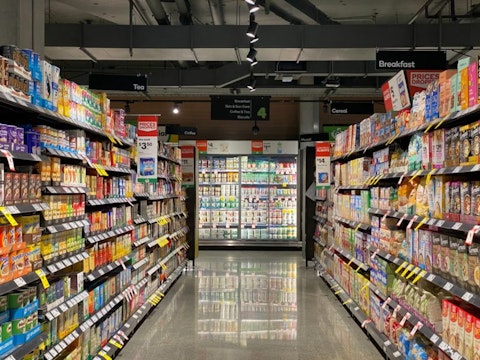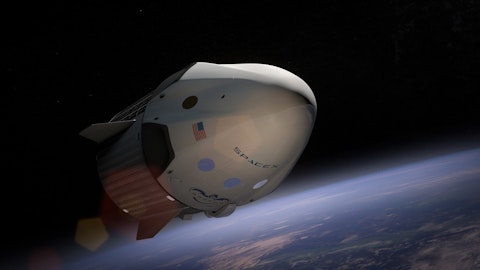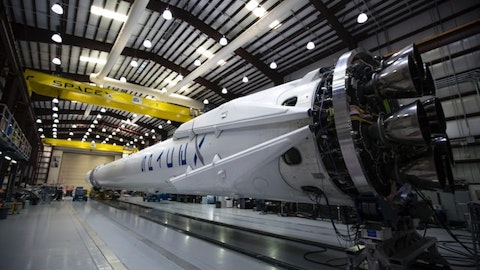In this article, we will be taking a look at the 16 largest grocery chains in the world. To skip our detailed analysis, you can go directly to see the 5 largest grocery chains in the world.
The evolution of grocery stores has ensured that shopping has changed from a painful task to a joyful one, though also a more expensive one, considering the myriad of options that one has nowadays. This has resulted in shoppers not just spending more time in grocery stores, but also spending more money, with data showing that even in 2022, when inflation impacted spending patters of consumers, grocery spend still increased in the UK. Further, in the same country, a study showed that consumers would spend more than 18 hours in grocery stores monthly.
Brick and mortar grocery stores are facing a huge challenge though, one which has only increased since the Covid-19 pandemic; online grocery stores purchases. While online grocery stores have been around for a while now, once the pandemic hit and lockdowns were imposed, physical stores were mostly closed down and people were restricted from leaving their homes. This led to people resorting to online shopping and discovering the comfort of ordering whatever they want from the comfort of their own homes. While the benefits are numerous, some drawbacks exist as well, with some stores taking a few days to deliver goods which doesn’t work in situations where groceries are needed urgently for cooking or cleaning. Also, many stores charge delivery fees which increases the overall cost of groceries and might not be feasible for those on a budget. Another issue exists mostly for people who live alone, who require only small quantities at any given time, especially in case of perishables. Often, the online versions of the largest grocery chains in the world have a minimum order quantity, and those who don’t, charge much more in additional fees. Because of these reasons, physical grocery stores are expected to stay around for a long time.

Photo by Franki Chamaki on Unsplash
If grocery chains are to continue attracting people, they need to incorporate technology to make the entire experience easier and better for customers. Many grocery chains have already started to implement technology and have been doing so for a while, such as implementing self-checkout machines across stores in Europe, the U.S. and Canada, which makes it easier and faster for customers to check-out. This also has benefits for the grocery stores themselves as they don’t need as much staff. It’s also beneficial for people who prefer to avoid interacting with people and can easily shop without worrying about having to converse with cashiers. In a similar vein, tourists shopping in grocery chains can use self-checkout machines which often have multiple language options, as opposed to cashiers who would be limited in their understanding of foreign languages.
As technology continues to improve, some grocery stores such as Amazon.com, Inc.’s (NASDAQ:AMZN) Amazon Go stores which first opened in 2018. These stores don’t have any staff whatsoever, and advanced cameras scan the items being selected by a person and charges them directly, not even requiring self-checkout machines. Other grocery chains such as Żabka in Poland have opened similar stores as well. Amazon.com is permanently closing 8 of these Amazon Go stores in Seattle, New York, and San Francisco, so it isn’t clear yet whether these types of stores have any future.
Right now, the 2023 outlook for the grocery chain industry and the biggest grocery chains in the world in particular is not very promising, as raging inflation is likely to have a significant impact on consumer spending. While inflation seemed to have peaked in 2022, it is still expected to be much higher than pre-2022 rates in 2023, only to fall in 2024. When inflation is high, many consumers are priced out of goods while their disposable income is impacted, because of which overall spending is reduced. A 2023 Consumer Trends report cited that close to half of consumers will reduce their overall spending in 2023 while more than 60% were concerned about their financial situation.
Retailers will also need to rethink their operational strategy to continue reducing costs. Rising energy costs are just part of the impact on higher costs for grocery store operators which include automated warehousing and fulfilment operations, which can help cut costs and improve margins. Global supply chain issues and shortages have impacted most industries which includes the supermarket industry, and a possible solution is AI-enabled supply chain that can improve scalability and minimize warehousing costs. AI is the future and it can also provide feedback for better resource management. At the end of the day, to be competitive in an incredibly competitive industry, it is important to reduce costs and the company which maximizes the usage of technology will win out over its competition.
As mentioned earlier, in-store purchases are increasingly threatened from online stores and to counter that, physical stores need to focus on renovation and implementing innovation to provide a memorable shopping experience to customers. According to the European Supermarket Magazine, 45% of consumers order directly from brands while nearly half were willing to share their data on their product usage. Customers are also willing to pay more for higher quality products, though this will be impacted by higher inflation rates.
Of course, to remain competitive, the biggest grocery chains in the world need to implement seamless online grocery stores as well as increase their online presence, mainly through social media, as a large percentage of customers discover new brands and items, a number that increases when you consider only Gen Z.
To determine the biggest grocery chains in the world, we consulted a report by Supermarket News, and filtered out only grocery stores from their list of largest retailers. This meant excluding companies such as Walmart Inc. (NYSE:WMT), Amazon.com, Inc. (NASDAQ:AMZN) and Costco Wholesale Corporation (NASDAQ:COST) as they aren’t technically just grocery chains. We obtained their grocery chain revenue from the report by Supermarket News and determined their number of locations from their websites or annual reports. We then assigned 70% weightage to revenue and 30% weightage to number of locations to come up with our list. So, let’s now take a look at the grocery chains you are most likely to shop around in, starting with:
16. Wegmans
FY 2020 revenue (in $ million): 10.68
Total number of global locations: 105
Headquartered in New York, Wegmans operates predominantly in Mid-Atlantic and Northeastern regions of the United States.
15. Southeastern Grocers
FY 2020 revenue (in $ million): 9.64
Total number of global locations: 523
The largest grocery chains in the world are predominantly in the U.S. and Southeastern Grocers is no exception, with the Florida-based company scoring the worst on human rights based on their tuna sourcing programs.
14. Giant Eagle
FY 2020 revenue (in $ million): 10.35
Total number of global locations: 474
Operating in multiple states including Pennsylvania, Indiana, Ohio, Maryland and West Virginia, Giant Eagle has 37,000+ employees and just parted ways with its CEO of 11 years.
13. Hy-Vee
FY 2020 revenue (in $ million): 12.15
Total number of global locations: 265
Operating in Midwestern and Southern United States, Hy-Vee is currently leading market share within the region along with the biggest grocery chain in the world. However, the company was recently in the news after the Environmental Protection Agency issued a penalty for violating its pesticide order.
12. Associated Wholesales Grocers
FY 2020 revenue (in $ million): 10.63
Total number of global locations: 3,100
Associated Wholesales Grocers operates over 3,000 stores across 36 states, earning over $10 billion in annual revenue. Recently, the company renewed its 15 year relationship with Givex Corp, a Toronto based company.
11. Wakefern Food Corporation
FY 2020 revenue (in $ million): 18.37
Total number of global locations: 363
Wakefern Food Corporation is the largest retailers’ cooperative group of supermarkets and one of the largest cooperatives of any kind in the U.S. Despite all the issues faced by grocery chains across the world, Wakefern Food Corporation still reported record revenue of $18.6 billion, an increase of 4.7% versus the previous year.
10. Metro
FY 2020 revenue (in $ million): 14.26
Total number of global locations: 1,601
The third-largest grocery chain in Canada, Metro currently has more than 90,000 employees. Metro is one of Canada’s grocery chains which have been under fire for alleged price-gouging, though its CEO has pushed back to state that is simply not true, even as the company along with others have been grilled by MPs with respect to food inflation.
9. Trader Joes
FY 2020 revenue (in $ million): 16.50
Total number of global locations: 530
Headquartered in California, Trader Joes has over 50,000 employees across its 500+ locations. Frozen strawberries at Trader Joes in addition to some of the other biggest grocery chains in the world, have been recalled due to concerns of Hepatitis A.
8. H-E-B
FY 2020 revenue (in $ million): 31.75
Total number of global locations: 351
H-E-B is a grocery store chain which is predominantly in Texas, with 351 stores across the state with some stores also operating in northeast Mexico. The company is continuing to launch new products to reduce costs for customers who prefer store brands rather than name brands in a bid to reduce their expenses.
7. Aldi
FY 2020 revenue (in $ million): 18.44
Total number of global locations: 2,070
Aldi, one of the largest grocery chains in the world, is a German company is set to close hundreds of stores along with Morrisons and Sainsbury’s. Recent data also showed that Aldi is one of the grocery chains which saw some of the largest price rises in the UK. While the company is planning to incorporate a £6 million store in the UK, several objections have put the plan at peril.
6. Sobeys
FY 2020 revenue (in $ million): 26.59
Total number of global locations: 1,933
Sobeys is the second-largest grocery store chain in Canada which has nearly 2,000 locations and operations in all provinces in the country. Owned by Empire Company, Sobeys was recently the victim of a cybersecurity breach which reportedly cost it around $30 million.
Click to continue reading and see the 5 largest grocery chains in the world.
Suggested articles:
- Mario Gabelli’s Performance and 13F Portfolio
- 15 Best High Yield Dividend Stocks to Buy
- 15 Most Promising Stocks to Buy According to Analysts
Disclosure: None. 16 largest grocery chains in the world is originally published at Insider Monkey.





